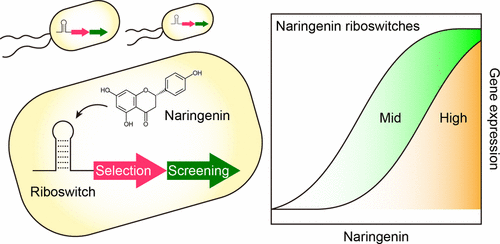当前位置:
X-MOL 学术
›
ACS Synth. Biol.
›
论文详情
Our official English website, www.x-mol.net, welcomes your
feedback! (Note: you will need to create a separate account there.)
Development of Artificial Riboswitches for Monitoring of Naringenin In Vivo
ACS Synthetic Biology ( IF 3.7 ) Pub Date : 2017-08-10 00:00:00 , DOI: 10.1021/acssynbio.7b00128 Sungho Jang 1 , Sungyeon Jang 1 , Yu Xiu 2, 3, 4 , Taek Jin Kang 5 , Sang-Hyeup Lee 6 , Mattheos A. G. Koffas 2, 7 , Gyoo Yeol Jung 1, 8
ACS Synthetic Biology ( IF 3.7 ) Pub Date : 2017-08-10 00:00:00 , DOI: 10.1021/acssynbio.7b00128 Sungho Jang 1 , Sungyeon Jang 1 , Yu Xiu 2, 3, 4 , Taek Jin Kang 5 , Sang-Hyeup Lee 6 , Mattheos A. G. Koffas 2, 7 , Gyoo Yeol Jung 1, 8
Affiliation

|
Microbial strains are considered promising hosts for production of flavonoids because of their rapid growth rate and suitability for large-scale manufacturing. However, productivity and titer of current recombinant strains still do not meet the requirements of industrial processes. Genetically encoded biosensors have been applied for high-throughput screening or dynamic regulation of biosynthetic pathways for enhancing the performance of microbial strains that produce valuable chemicals. Currently, few protein sensor-regulators for flavonoids exist. Unlike the protein-based trans-regulating controllers, riboswitches can respond to their ligands faster and eliminate off-target effects. Here, we developed artificial riboswitches that activate gene expression in response to naringenin, an important flavonoid. RNA aptamers for naringenin were developed using SELEX and cloned upstream of a dual selectable marker gene to construct a riboswitch library. Two in vivo selection routes were applied separately to the library by supplementing naringenin at two different concentrations during enrichments to modulate the operational ranges of the riboswitches. The selected riboswitches were responsive to naringenin and activated gene expression up to 2.91-fold. Operational ranges of the riboswitches were distinguished on the basis of their selection route. Additionally, the specificity of the riboswitches was assessed, and their applicability as dynamic regulators was confirmed. Collectively, the naringenin riboswitches reported in this work will be valuable tools in metabolic engineering of microorganisms for the production of flavonoids.
中文翻译:

用于体内柚皮素监测的人工核糖开关的开发
微生物菌株由于其快速的生长速度和适合大规模生产的能力,被认为是生产类黄酮的有希望的宿主。然而,目前的重组菌株的生产率和滴度仍然不能满足工业过程的要求。遗传编码的生物传感器已用于生物合成途径的高通量筛选或动态调节,以增强产生有价值化学物质的微生物菌株的性能。目前,很少有用于类黄酮的蛋白质传感器调节剂。不像基于蛋白质的反式调节控制器,核糖开关可以更快地响应其配体并消除脱靶效应。在这里,我们开发了一种人造核糖开关,可响应柚皮素(一种重要的类黄酮)激活基因表达。使用SELEX开发了柚皮素的RNA适体,并将其克隆到双重选择标记基因的上游以构建核糖开关文库。体内两个选择途径通过在富集过程中补充两种不同浓度的柚皮素来分别应用于文库,以调节核糖开关的操作范围。所选的核糖开关对柚皮素和激活基因表达的响应高达2.91倍。核糖开关的操作范围根据其选择途径进行了区分。另外,评估了核糖开关的特异性,并确认了其作为动态调节剂的适用性。总的来说,这项工作中报道的柚皮苷核糖开关将是微生物代谢工程中用于生产类黄酮的有价值的工具。
更新日期:2017-08-10
中文翻译:

用于体内柚皮素监测的人工核糖开关的开发
微生物菌株由于其快速的生长速度和适合大规模生产的能力,被认为是生产类黄酮的有希望的宿主。然而,目前的重组菌株的生产率和滴度仍然不能满足工业过程的要求。遗传编码的生物传感器已用于生物合成途径的高通量筛选或动态调节,以增强产生有价值化学物质的微生物菌株的性能。目前,很少有用于类黄酮的蛋白质传感器调节剂。不像基于蛋白质的反式调节控制器,核糖开关可以更快地响应其配体并消除脱靶效应。在这里,我们开发了一种人造核糖开关,可响应柚皮素(一种重要的类黄酮)激活基因表达。使用SELEX开发了柚皮素的RNA适体,并将其克隆到双重选择标记基因的上游以构建核糖开关文库。体内两个选择途径通过在富集过程中补充两种不同浓度的柚皮素来分别应用于文库,以调节核糖开关的操作范围。所选的核糖开关对柚皮素和激活基因表达的响应高达2.91倍。核糖开关的操作范围根据其选择途径进行了区分。另外,评估了核糖开关的特异性,并确认了其作为动态调节剂的适用性。总的来说,这项工作中报道的柚皮苷核糖开关将是微生物代谢工程中用于生产类黄酮的有价值的工具。











































 京公网安备 11010802027423号
京公网安备 11010802027423号